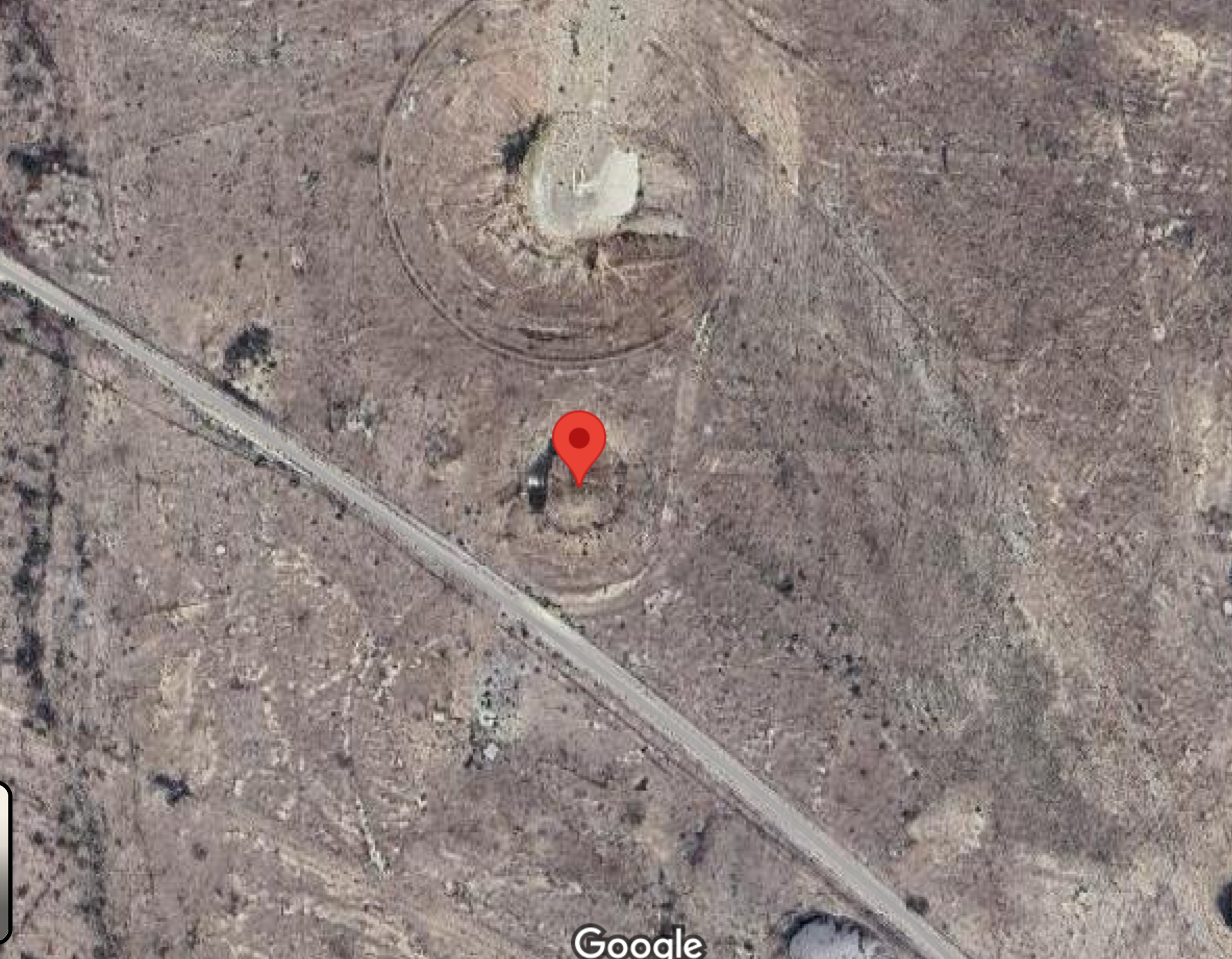Nuclear Weapons
HOME
Table of Contents
- A House of Dynamite (2025) Movie Review
- My US Nonstrategic Nuclear Arsenal Presentation
- Unique LASL Test Footage
- My Visit to the Atomic Cannon
A House of Dynamite (2025) Movie Review
12/2/2025
A House of Dynamite (2025) is a movie produced by Kathryn Bigelow (known for Zero Dark Thirty and The Hurt Locker) centered around the world of nuclear deterrence and nuclear command, control, and communications (NC3). The driving force for the film is that a ballistic missile is inbound to strike Chicago, but its origins are not clear due to either a technical malfunction or deliberate interference with ballistic missile detection satellites. The plot unfolds via multiple perspectives: the missile defense forces in Alaska, US Strategic Command (STRATCOM), SECDEF, The White House, POTUS, and others. The actual events of the movie span 15-20 minutes (a realistic response time for an incoming ICBM), but the movie clocks a runtime of 1 hr 55 mins. Ultimately, the major concept explored is the weight of the nuclear decision making process and stark reality of a modern nuclear attack.
There are immediately some plot points I take issue with, such as the idea that a singular ICBM would be launched without warning or any preceding tensions (called a “bolt out of the blue”), with no intelligence as to where it originated. Is this highly unrealistic? Yes. With that being said, realism isn’t always the end all be all. When it comes to these kinds of movies I think at times it is worthwhile to suspend disbelief momentarily to allow the writer to have a platform to explore the central issue of the film. If this movie honed in on too specific of a threat as being the culprit the writer could have gotten wrapped up into all of the realities of that country’s geopolitical situation, their actual nuclear posture and capabilities, and the US response options the writer could explore may have been more narrow. On the other hand, this benefit of the doubt can only go so far. In trying to explore how the US responds, the writer ties their own hands by leaving the viewer wondering how can the President realistically respond to a threat when they have no intelligence on where it came from? Perhaps this feeling of ambiguity is something the writer was trying to convey, but the situation just becomes so far fetched at that point that the viewer has to wonder why the command structure is so keen to issue a response when there are no other incoming missiles and the origin and intent is completely unknown. The US has invested billions into building a second strike capability that can directly absorb a nuclear attack and still be capable of responding in kind. The idea that POTUS must take action prior to the missile detonating over an urban center is difficult to buy into when the second strike capability would still be there afterwards.
I mentioned earlier as well that the response time to the attack is around 15-20 minutes, yet the movie is about 1 hr 30 mins worth of actual film. This is something that threw up some red flags in my head right away. The inciting event occurs within the first 15 minutes of the film (begin 20 min countdown), so how does the writer plan to fill the rest of the runtime? Their choice was to explore multiple perspectives, allowing them to stretch that response time into a full movie, but I think it was stretched thin. There is only so much information offered to the viewer throughout each cycle of the response drama, and while the different perspectives offer something in the way of an emotional story (with SECDEF having a daughter in the strike zone), there isn’t much information gained about the unfolding crisis from these perspectives. I think this movie would have been better off having a 1st act centered around an unfolding global crisis and seeing what different information can be offered from different perspectives. For instance, let’s say Russia is struggling to keep the edge in Ukraine leading to a limited nuclear war. This can be explored from the eyes of the military via NORTHCOM, while raw intelligence is shown from SIGINT intercepts from a sub in the North Atlantic, and back channel diplomatic messaging is seen from a CIA/State Dept. perspective. Now, the writer may not want to be so specific since that would get them wrapped up into all the current realities of the Ukraine war and Russian policy, but something to this effect would have been more compelling.
I also took issue with the way the military responded to the threat. The Greeley missile defense base launched one Ground-Based Interceptor (GBI) to intercept the ICBM, which missed. These defenses are portrayed as having a 61% success rate, which is not accurate. This number comes from averaging all GBI test results since the late 1990s. They have obviously improved considerably since then and have better success rates, which only increase with the more GBIs launched, leading to another gripe. The Greeley operators only launched one GBI against the missile (which is justified as a way to maintain missile inventory) and upon failure to intercept they don’t launch another. This is beyond suspension of disbelief. After confirmation of the miss the operators basically give up and call it a day. This lack of professionalism is completely uncharacteristic of these operators. This behavior is extended all the way up to the commander of STRATCOM who is portrayed as incredibly hawkish, damn near twisting the arm of POTUS to issue a response. The people in this field live and breath nuclear deterrence, always ready to respond at a moments notice, so I believe if the real thing were to happen they would display utmost thoughtfulness and procedural adherence, unlike what this movie portrays. Now, even though the movie did make the military seem unprofessional at times, I generally appreciate how the film can serve as a reminder to the viewers that there are thousands of men and women who serve day in and day out to support our strategic defenses. These service members and civilians make great sacrifices in a field that is often forgotten, but which literally serves as a core foundation for all US foreign policy.
While I do have problems with this movie (some of which I am leaving out for brevity), I still do appreciate that it exists and I enjoyed some parts of it. I especially liked the visual aspects, it is clear the team had a healthy amount of support from experts. Given the CIA assistance in making Zero Dark Thirty, Kathryn Bigelow clearly has the right friends to get the small details right. As someone who is deeply interested in nuclear weapons and deterrence, this movie gave me a way to contextualize and make real many of the practical aspects of a nuclear response. For instance, the way B-2 bombers were shown proceeding to their loiter positions for a launch order was a good reminder that these weapon systems (including the new B-21 Raider) are primarily nuclear bombers. The NC3 details were very interesting as well, like the Nuclear Decision Handbook or “Black Book” and the Presidential Emergency Satchel or “Nuclear Football.” Besides making for good eye candy, the main thing I appreciate about this movie is how it can start a conversation about nuclear weapons and the current state of deterrence. I have seen countless examples of people being misinformed or holding wild misconceptions about nuclear weapons. I hope that if they watch this movie it may direct them to researching the topic and becoming more informed about the current state of nuclear deterrence and breaking away from outdated Cold War beliefs that have no place in the 21st Century. Perhaps if that is too much to ask, it will remind people of the grave reality that nuclear war is always a possibility, more now than ever. As we continue grappling with a multi-polar world order, with increasing tensions between the US and China (where war is often discussed as an assumed certainty) the threat of nuclear war only continues to grow. People should keep this at the front of their mind as it may change how they think about world affairs and how the US should play its hand.
Nonstrategic Nuclear Weapons Arsenal Video
01/22/25
I've finally written a script and recorded the video for my nonstrategic nuclear weapons presentation. The slides can be found on my Projects page. The video can be found here. The first 21 minutes are dedicated to some preliminary topics, so if you just want a list of the weapons then skip to 21:10. Hopefully you will enjoy it and learn something.
Unique LASL Test Footage
01/21/25
I've been a nuclear nerd for a long time, so naturally I've been reading about and watching videos on the topic for a long time as well. I remember in about 2011 or 2012 finding this video from Atomcentral (basically THE place for archival nuclear test footage). The footage is of the infamous Castle Bravo test at Bikini Atoll in 1954, a topic which deserves its own write up. More to the point though, what struck me was the massive scale of the rising fireball in conjunction with the eery droning sound of the bombers engines. The imagery is apocalyptic, and the veterans of the test would go on to describe it as such. This video was not the only thing that sparked my curiosity about nuclear science, but it absolutely stoked my interest in nuclear weapons and the history of the Cold War. Over the years, I have sought out many lesser known pieces of test footage and contemporary documentaries about nuclear weapons (like Sandia National Laboratories docs "US Strategic Nuclear Policy: An Oral History" and "On Deterrence," among others). So, imagine my surprise when I found a compilation of footage I'd never seen before, with new, interesting angles on tests. The video was uploaded 14 years ago and is titled simply "Nuclear explosion shock waves."
The footage was created in collaboration between the Atomic Energy Commission, EG&G (major contractor for the nuclear program at the time), Los Alamos Scientific Laboratory (now Los Alamos National Laboratory), and the DOD. I want to discuss some tidbits about this footage I find interesting. The first clip has a great aerial view of a detonation, even though the camera is not on the subject for very long. The second clip (starting at 0:53) is also quite neat. The device tested is very low yield (almost surely \( \le 1 \) kt), so it is interesting to see the way the rising fireball immediately starts to suck up dirt and dust as the heavier air rushes in to fill the void of the quickly rising hot ball of gas. Also, I think it gives a good idea of what small tactical weapons (like the Davy Crockett or atomic demolition munition) would look like. A bit later, at 1:58, there is a fantastic angle on a detonation. The view is what one might see viewing a nuclear strike (as opposed to far away at a "safe" distance), and I think this makes it even more unique. The moment of the burst the film is oversaturated, but directly after you can see how quickly the fireball leaps away from the ground and how the thermal radiation burns the entire immediate area. I've been studying Glasstone and Dolan's "The Effects of Nuclear Weapons" (1977) for an upcoming post, but in it they discuss how the immediate thermal radiation from the burst is transferred to the surroundings, and I think this makes for an illuminating example of that process. Next, from 3:06, we get an angle on the way rocket smoke trails were used to understand the shock front, or blast wave, from the detonation.
At this point, I was starting to wonder if a lot of this footage may have come from the Grable shot of Upshot-Knothole (which I wrote more about in my atomic cannon piece), since the footage looks so similar to the Grable footage. Perhaps this is just because the similar weapon yields (tens of kilotons), burst heights of airbursts (usually low), and procedures used at the Nevada Test Site. Not sure. I especially think that the device at 3:40 is the Grable shot. The decending globs of smoke and dust from the inside of the toroid (the churning top of the mushroom cloud) are distinctive, but again I cannot say with 100% certainty. It is definitely part of the Desert Rock exercises though, since I have seen this cloud in other footage with military maneuvering tests. The following slow-mo footage at 4:24 is especially interesting since it shows the way the shock wave reflects off the ground and changes the shape of the growing fireball. The colors are also quite stunning, but not accurate to what you or I would see. The next clip I want to highlight is at 6:16. Again looking at the shock front, we see how using an air burst enhances blast destruction by creating two shock fronts using reflection. One travelling from the initial detonation (incident blast) and the other coming from the reflection of the first blast wave (reflected blast), just shortly after the initial blast hits. The below image from Ch. 3 of "The Effects of Nuclear Weapons" (start at Sec. 3.21) shows this behavior well.
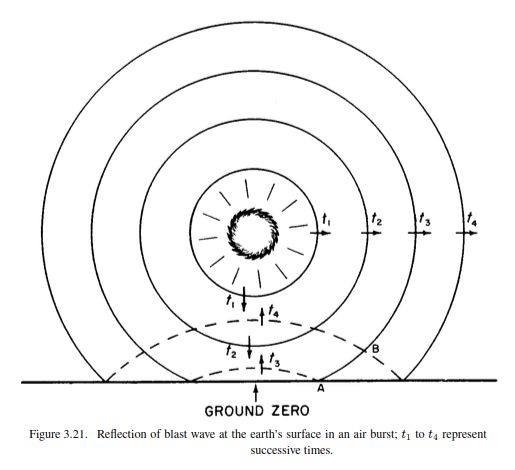
An air burst at the correct height can maximize overpressure, and therefore destructive potential to light structures, by taking advantage of this phenomena. The reflected blast will have some proportion more overpressure than the incident blast, giving a two for one punch on the target. This overpressure is shown in the below graph, from the same source.
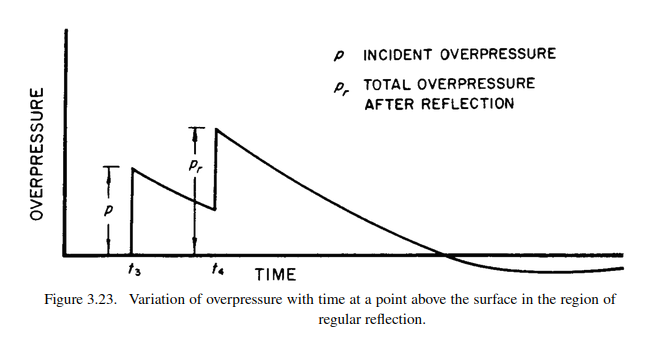
Notice for these clips that there are different angles between the incident blast and the reflected blast. This is where the reflected blast is beginning to catch up with the incident blast, and they start to combine into a unified shock front called the "Mach stem." See below (from Effects (1977)).
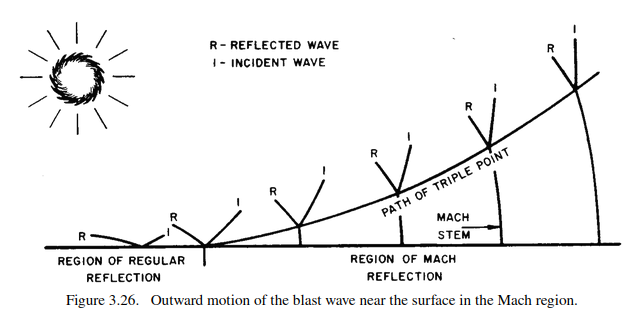
Moving back to thermal effects, the clips at 7:59 are a good example of how the outer shell of the fireball develops. At first, right after detonation, about 70-80% of the bombs energy is dumped into the surrounding few feet of air as thermal radiation in the form of soft x-rays. These x-rays ionize the air and impart a tremendous amount of energy to it. This causes the air to become extremely hot and violently expand outward while reradiating its energy across the electromagentic spectrum (UV, visible, and IR). The superheating, sudden cooling by reradiation, and violent expansion of the air causes it to become very dense, so dense in fact that it briefly becomes opaque to the intense light of the still madly glowing fireball within. This can be seen as a slight dimming of the outer edge of the fireball, before it brightens again as the internal hot gases rush outward at supersonic speeds. This phenomena is known as "nuclear double flash" and is what the Vela satellites exploited to detect the detonation of nuclear weapons. The instruments, called bhangmeters (funny story behind the name, check the wiki) still exist on satellites in low earth orbit watching below for any nuclear detonations. I believe some are also stationed in major cities on utility poles, or at least they used to do that as an early warning system. The time between the first flash and the second flash can be an indicator of the yield of the weapon, and the time increases as weapon yield increases. So, for footage of megaton range weapons, the double flash will be obvious even without slow motion. I love seeing the double flash and I think it is an amazing display of just how powerful these reactions are that they can compress and superheat air until light can no longer pass through easily.
The rest of the video goes through some test footage from Trinity and some rapatronic camera shots. Overall, I think there are some unique clips in here and they make great examples of some of the consequences a nuclear detonation, namely thermal radiation and blast effects. I hope you enjoyed looking more in-depth into this footage and thanks for reading!
My Visit to the M65 Atomic Cannon
The M65 atomic cannon, a 280 mm gun, is a nuclear-capable artillery piece from the early days of the Cold War (1950s). It rested on a massive steel structure supported by a turnstyle that could be used to make major adjustments to the azimuthal angle of the gun. Given it's huge size, it required two large trucks to move, as shown below (don't let the perspective fool you, I took this on 0.5x. See my pictures page for a pic of me in front of the trunion area).
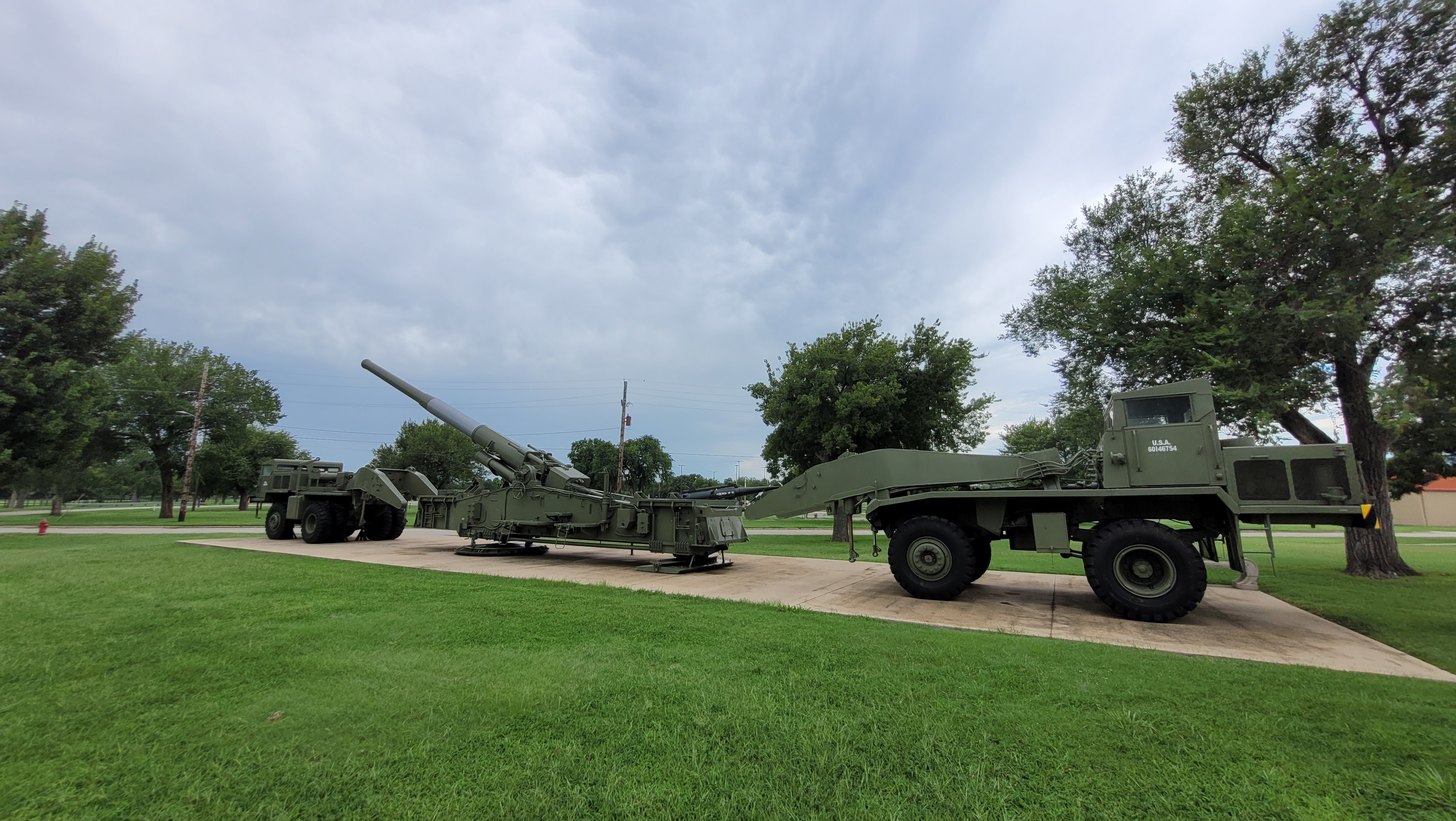
One of these guns, nicknamed "Atomic Annie" (above) was used to deploy a nuclear artillery shell in the Grable shot of the Upshot-Knothole series of nuclear tests at the Nevada Test Site (formerly Nevada Proving Ground) in 1953. The artillery shell produced a yield of approximately 15 kilotons. This was accomplished by the W9 warhead, which was one of the few highly enriched uranium (HEU) gun type weapons maintained by the US. We later moved over to implosion-type plutonium weapons exclusively (although, these still can involve the use of HEU, just not as the primary fissile material). A video of the test can be found here. Another pic of the gun is below.
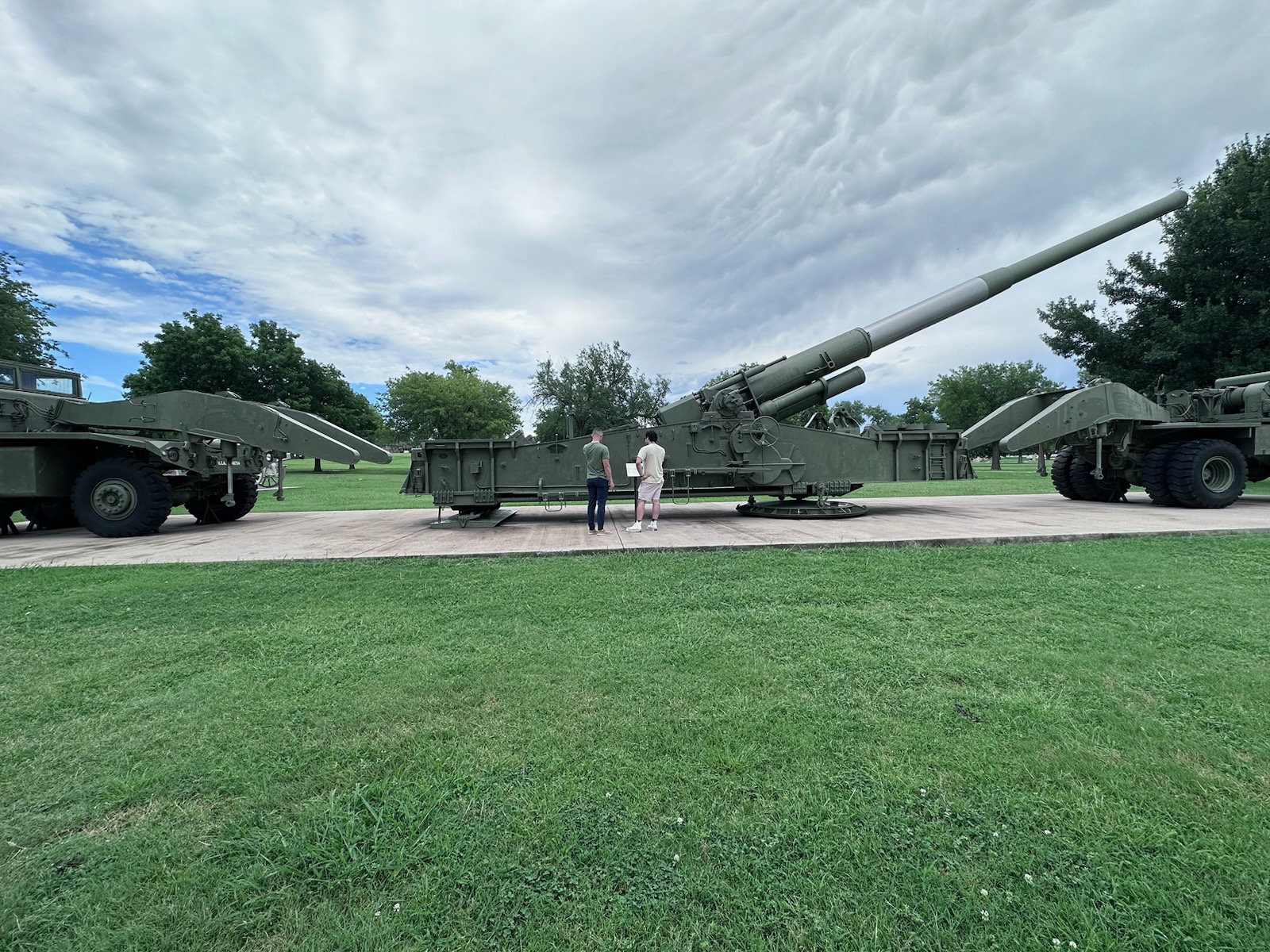
Something I find particularly fascinating about this weapon system is that the US was able to go from the crude Mk-1 "Little Boy" device used in 1945 against Japan, to a miniaturized warhead deployable on artillery shells with the same yield in the matter of a few years. General Douglas MacArthur actually pressed President Truman to approve the use of nuclear weapons against the North Korean forces during the Korean war, with 8 of these 280 mm guns being deployed to theater with a complement of nuclear shells [I will need to come back with a specific source, but I believe this is discussed in 15 Minutes: General Curtis LeMay and the Countdown to Nuclear Annihilation]. You can read more about MacArthur's crazy plan to wage nuclear warfare against the Koreans and Chinese here. What I found particularly wild from this article was his plan to use "enhanced radiation weapons" (a.k.a. cobalt bombs or salted nukes) to deny the enemy entry through the northern border between Korea and the USSR and China.
Upshot-Knothole Grable
Operation Upshot-Knothole would serve many purposes, from studying the effects of nuclear weapons on combat operations and demonstrations of weapons platforms to research on the radiation implosion mechanism and enhancing civil defense preparations. The DoD was highly involved in Upshot-Knothole, with around 20,100 DoD personnel being involved in the test. One thing I found notable was that the Marine Corps performed operational tests of helicopters in the presence of a nuclear detonation which were "designed to investigate the capability of helicopters and their crews to withstand a nuclear burst and its effects" [Defense Threat Reduction Agency, Upshot-Knothole Factsheet].
The Grable shot itself took place at 0830 PDT on May 25, 1953 at Area 5 of the Nevada Test Site, known as Frenchman Flat (shown below). The device was delivered by the 280 mm M65 atomic cannon with an airburst height of 524 feet. The cannon was manned by the Artillery Test Unit out of Ft. Sill in Lawton, OK (the gun itself now sits outside the US Army Field Artillery Museum at Ft. Sill). In addition to the usual DOE testing, more than two and a half thousand troops and 700 observers were placed in trenches 2.8 miles from ground zero to see the detonation and then navigate into the affected zone to survey the effects on equipment placed around ground zero. This was part of the Desert Rock exercises, specifically Desert Rock V. They got within 0.9 miles of ground zero before stopping due to a dust storm. Following this, they were to attack two locations as part of an exercise. One was 1.5 miles SE of ground zero and the other was 1.7 miles ESE of ground zero. Some of these troops got within 0.4 miles of ground zero and were able to view destroyed equipment 0.1 miles away. Again, these oberservers had to abort their planned exercise due to dust storms.
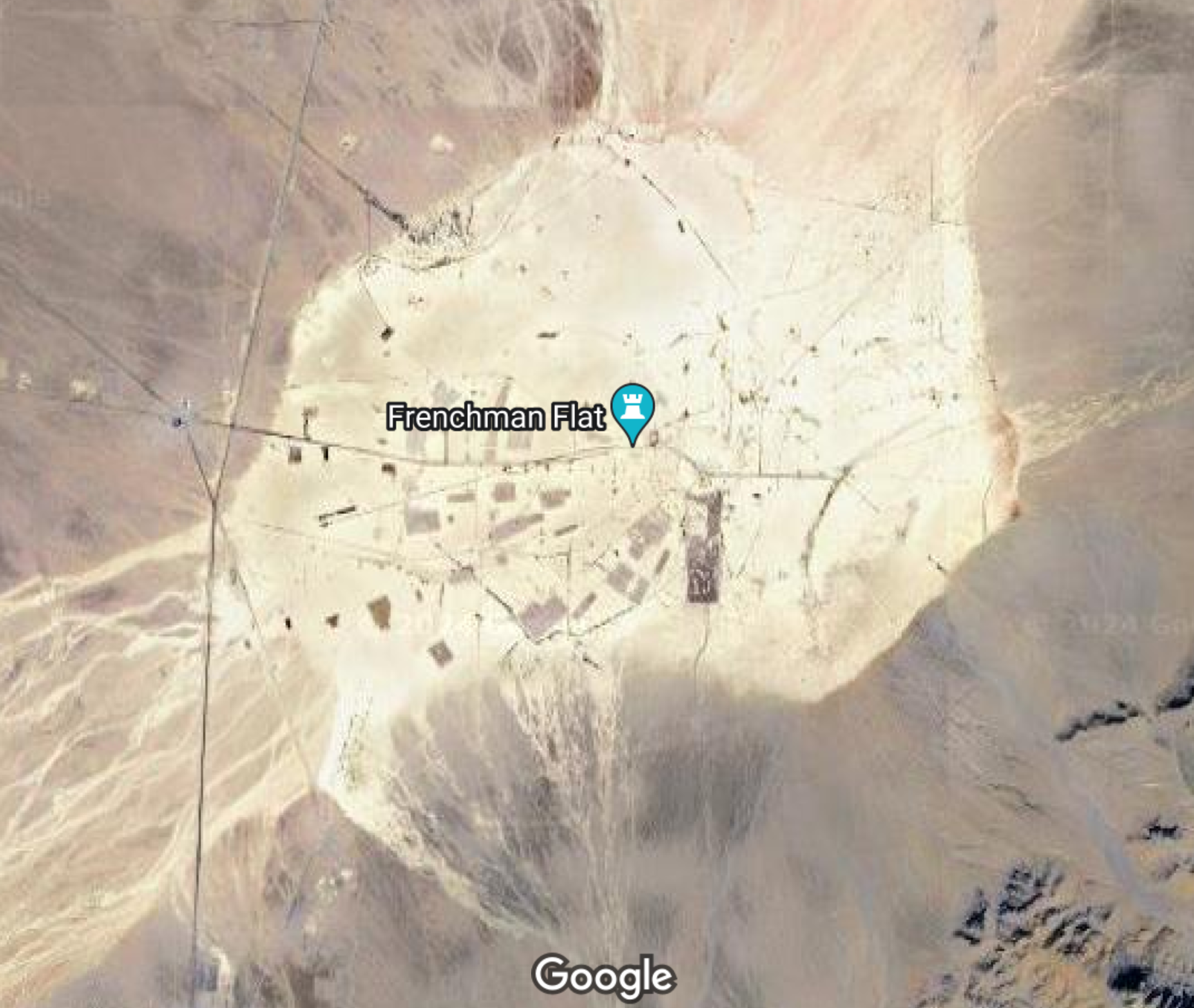
At this point, you may be wondering what the hell people were doing within a half mile radius of a fresh nuclear burst. The Army's Office, Chief of Army Field Forces (OCAFF) set blast overpressure and ionizing and thermal radiation exposure limits for the military observers. From this, they determined minimum distances to ground zero. OCAFF set the gamma exposure limit of these troops to 6.0 roengten (R), with only 3.0 R allowed to be absorbed from prompt radiation (radiation given off directly from the nuclear burst) [Defense Threat Reduction Agency, Upshot-Knothole Factbook]. For comparison, the dosage limits of a radiation worker in the US are 0.3 roengten equivalent man per week (rem/wk) or 5.0 rem/yr. The dosage limit for a typical citizen is 0.100 rem/yr. The NRC guidelines are shown below.
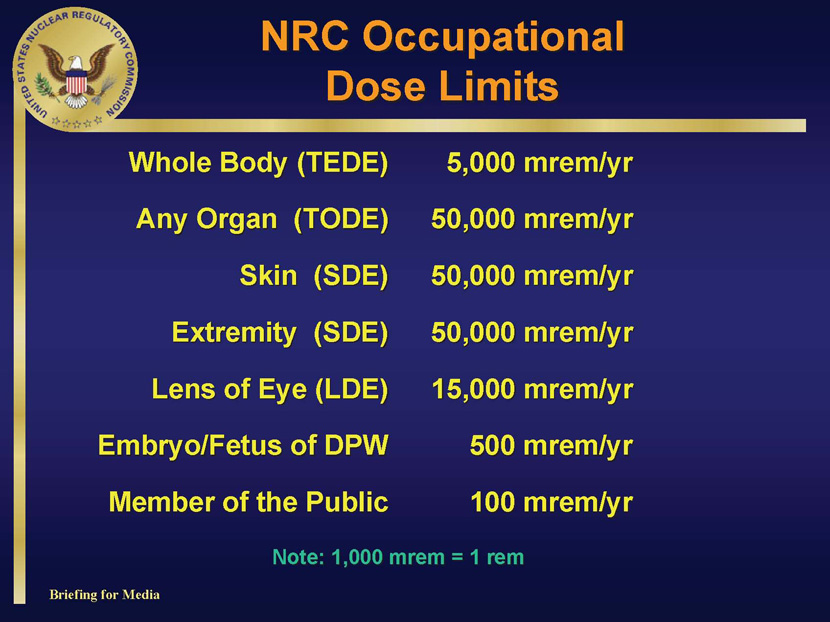
While I don't think these units (R and rem) are entirely equivalent, I think they illustrate the very lax safety standards around radiation exposure, especially in the form of fallout as part of nuclear tests. According to Nuclear Weapons Archive, 3,000 soldiers exceeded these maximum dosages with the highest exposure being recorded at 26.6 rem [Nuclear Weapon Archive]. Even more alarmingly, a group of volunteers were granted maximum exposure limits of 10 R of gamma radiation (with 5 R allowed to come from prompt radiation) and a total limit of 25 R for the entire exercise! These volunteers were also given a maximum blast overpressure of 8 pounds per square inch (psi). An overpressure of 5 psi is usually enough to demolish most wood framed structures.
The W9 Warhead
Manufactured from April 1952 until November 1953, 80 W9 warheads were produced for use in the US Army's T-124 280 mm shell. The Los Alamos Scientific Laboratory (LASL, later renamed Los Alamos National Laboratory or LANL) designed the device. These shells were made to be used with the M65 cannon, of which only 20 were produced [Nuclear Weapon Archive]. The warhead used approximately 110 lbs of HEU to produce a yield of 15 kilotons (fixed yield). The device had fuzing options for setting the burst height. Eventually, the W9 would be retired in May 1957 in favor of the W19 warhead. The old W9s were converted into T4 Atomic Demolition Munitions (ADMs) [Nuclear Weapon Archive].
The W19 Warhead
Assigned to LANL in 1953, the W19 warhead was developed to replace the W9 and entered the US stockpile in 1956 (a year before the retirement of the W9) [Nuclear Weapons Databook Vol. I, Cochran, Arkin, and Hoenig]. It had a yield of 15-20 kilotons and would end up being retired in 1963 as the 155 mm based W48 warhead entered the stockpile. I imagine that the logistical ease of deploying 155 mm munitions over 280 mm was a contributing factor in the transition away from these large atomic guns.
More About US Gun Configuration Warheads
So, while the W9 of Upshot-Knothole Grable and Little Boy are the two most notable gun-type warhead detonations (especially since they were used in their "battle configuration" with the W9 being fired from the M65 and Little Boy used in combat), there were other gun configuration warhead tests. These tests were of the W33 warhead, which would be deployed in a 203 mm artillery shell. The two tests were shots Laplace of Operation Plumbbob and Aardvark of Operation Nougat, occuring in 1957 and 1962, respectively.
First, we will look at Plumbbob/Laplace. The Laplace shot was an airburst test using a balloon to suspend the device at 750 feet. The detonation occurred at 0600 PDT on September 8th, 1957 at the Nevada Test Site. The yield was comparably small at 1 kiloton. The test was used as an opportunity to see how well US Army radars could be employed to measure nuclear detonations, with teams detecting the detonation and tracking fireball and cloud growth. Using this data, they tested their ability to measure the weapon yield and predict fallout patterns. One can imagine how this information would be critical in the case of tactical nuclear weapons employment during a Soviet invasion of Western Europe. The shot was also used as an opportunity to understand more about nuclear weapons effects, with the Army, Navy, and Air Force all conducting their own research into the effects of high neutron-flux and gamma radiation [Defense Threat Reduction Agency].
For Nougat/Aardvark, the shot took place on May 12th, 1962 at 1900 Zulu-time (1200 local time). It was an underground test of considerably higher yield. The device was a TX-33 (experimental version of the W33) yielding 40 kilotons. It was buried 1424 feet (434 m) underground at Nevada Test Site, Area 3 (coords: 37° 7′ 39.14″ N, 116° 2′ 57.01″ W (sat view shown below)). This would be the United States' final test of a gun type fission weapon.
